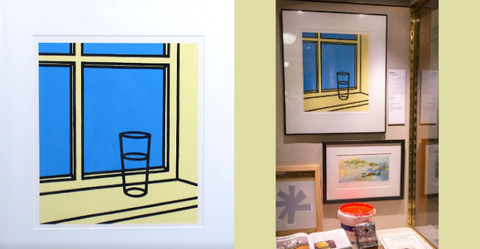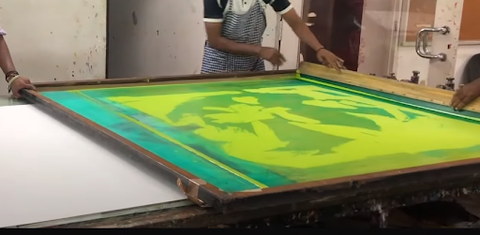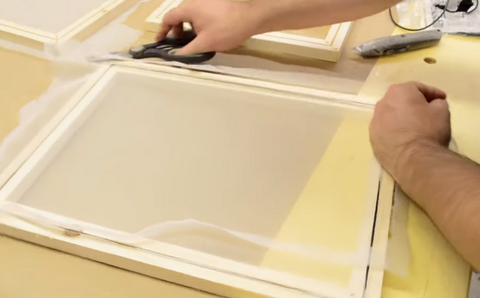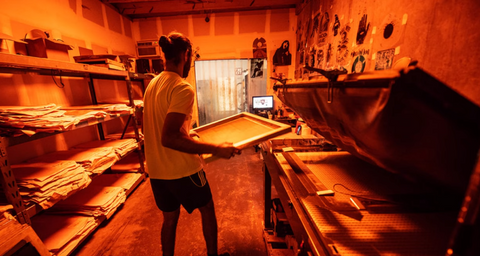You may have heard of serigraph art and might have seen it as well. Did you appreciate the quality and clarity of the art? Serigraph prints are indeed captivating in appearance. Not only that, they possess value as well because of the lengthy manual process involved.
Serigraph art includes an age-old painting technique that offers a way to have a renowned painting in your home. However, the majority of people need clarification about screen printing and serigraphy. Some believe both are the same, while others believe they are different. We are here to clarify the difference, process, characteristics, and value of art. Let’s begin the article and learn about the serigraphy process and its widely used applications.
Serigraph Vs. Silkscreen
Do silkscreen and serigraph mean the same thing? Some people mix up the terms, thinking they're different, but they're just two ways to say the same thing. The original word for serigraph was silk screening.
Initially, a regular laborer or employee at the sign store or shop conducted the printing. Still, lately, during the WPA period, the artists were brought to work under federal programs and assigned to the printmaking sections. Since the word silk screening was widespread, the artist did not like it, giving this process a more artsy word, ‘serigraphy.'
Seri means silk, and a graph is a drawing of silk. The only difference is that silk was initially used in silk screen material. But in modern times, artificial materials are used. The term "serigraph" was popularized by the American artist Anthony Velonis in the 1930s.

Serigraph Art Definition
The term serigraphy refers to screen printing. It employs a mesh screen to apply ink to various surfaces, including paper, fabric, metal, or plastic. Stencils are created on the screen, made with silk (from old times) or synthetic mesh (from modern times) stretched tightly over a frame. The mesh blocks off areas on the screen that are not meant to be printed. The ink is then passed through the open mesh spaces.

In serigraph printing, a squeegee is employed to push ink through the mesh onto the substrate. To create a multi-colored image, each color in the design needs a separate screen and printing pass. This process is mainly used in art, signage, and textiles. It has the versatility and ability to produce vibrant, opaque colors on various surfaces.
How To Create A Serigraph
Serigraph includes various steps while making prints. The following steps are involved in the serigraph process:
Design Preparation
- First, the artwork is selected, which needs to be reproduced as a serigraph.
- The art is then drawn on a transparent sheet with a black marker in layers for screen preparation. This method can be done manually or digitally. Graphic design software, or handwork, is mainly used for this purpose.

Screen Preparation
- Now, the screen is made with a piece mesh stretched over a frame, removing all wrinkles or slack. The mesh used to be made of silk, but now it's generally made with nylon or polyester. The quality of the print differs on both screens. However, silk gives more clarity.

- The screen is then coated with the light-sensitive emulsion from both sides. It is evenly and thinly applied to make sure there are no gaps. The process is done in a dark room with no UV light. The emulsion then dries in a dark environment.

Creation Of A Stencil
- When the emulsion is dry, a transparent sheet is placed upside down on the flat side of the screen. A glass is placed on the sheet to ensure the transparent sheet is flat against the screen.
- Now, the screen is exposed to sunlight or UV light, so the reaction occurs. The exposed area becomes hardened and doesn't wash away. The unexposed area remains soft enough to wash out.
- Finally, the screen is washed with water to remove the soft emulsion. After this process, the screen is ready for printing.

Printing
- Now, the screen is used on a substrate, usually paper, fabric, or another applicable material.
- The ink covers the whole surface of the silk, and a squeegee is used to spread the ink uniformly, which helps to transfer the required design onto the substrate.
- Distinct color layers are printed separately, enabling the creation of prints with various colors.

Drying And Finishing
- After applying each color, the print undergoes a comprehensive drying process before introducing the subsequent layer.
- Upon completion of printing and thorough drying of all layers, the final serigraph is finished.
- Certain artists may personally sign and assign a unique number to each print within a limited edition, enhancing the individual pieces' significance.
- The completed serigraphs are typically framed, presented for exhibition, or made available for sale.
The serigraphy process takes many weeks to complete, as it is a very labor-intensive and artistic procedure. The artist of the original image is consulted before the serigraphy process starts. Occasionally, artists prefer to introduce alterations while printing an edition, approaching the print as an original creation rather than a duplicate of a pre-existing image. In other circumstances, making adjustments or changes to the image highlights the specific colors or any particular design, which can result in the development of a vibrant and novel image.
Characteristics Of Serigraph Art
The vibrant color of serigraphy is due to the thick ink layers being applied directly over the surface, which makes the serigraphy more attractive, lively, and prominent. It is different from other artwork because it has a unique texture and depth that others do not have. The characteristics include;

- Unique texture when printed on canvas
- Allow for surfaces like paper, fabric, wood, metal, etc.
- Limited editions of serigraphs enhance their collectibility.
- Each print is hand-pulled, contributing to its rarity and uniqueness.
- Artists express their expression by layering to create a diverse effect.
How To Identify A Serigraph
Serigraphs come with such close approximations to original art that sometimes it is difficult to differentiate. But if you need clarification, take a piece of paper and feel it. The lithographic paper mostly has heavy grains; however, the serigraphy paper has a smooth texture. Moreover, the serigraph is a modern and versatile method of stencil painting. The serigraph is easily identifiable and consists of the following features:
- Limited colors that appear bold with flat surfaces compared to multiple indulging.
- When two colors overlap, the ridges can easily be felt in serigraphy.
- In serigraphy, the screen mesh pattern usually appears in printed ink, even without magnification.
- Different substrates are used in serigraphy, including paper, rigid acrylic sheet canvas, aluminum, etc.
- The fine art printing can be signed and numbered according to traditional manners.
- The artist's signature can be found in serigraph paintings.
- Limited editions are the predominant form of production for most serigraphs. So, observe for any numbering or edition size to identify.
- Look for any numbering or signing on the print or accompanying documentation.
Serigraphy In Industries
Besides identification and process making, Serigraph provides vast applications in different fields and industries, depending on demand. It is due to its versatility and ability to produce high-quality prints. Here are some applications of serigraphy in multiple fields
Fine Arts
The artists utilize serigraphs to produce limited-edition fine art prints, which allow them to create the desired number of collectible artworks. Moreover, serigraphy will enable artists to experiment with different colors and layers to introduce various creative expressions.

Commercial Printing
Serigraphy is widely used for art prints, posters, and other promotional materials like banners. It is also utilized in advertisement campaigns for large-format prints and signage.
Textile Industry
Serigraphy is extensively used in the textile industry to print various designs on T-shirts, hoodies, and garments, especially for children. Furthermore, the designers also utilize screen printing for interiors, home decor, and other fashion industries.
Packaging And Promotional Products
Serigraphy creates visually appealing packaging products like custom boxes, labels, or other containers. It also allows customization, contributing to brand identity and recognition. Moreover, this marketing method is famous for promoting merchandise like cushions, mugs, and other accessories. Therefore, it provides cost-effectiveness and versatility.
Circuit Printing And Sports Industry
Serigraphy is also used in the electronic industry to print various conductors, circuit boards, and other electrodes, creating precise and intricate patterns. The sports industry uses it for making team uniforms, logos, numbers, and designs that ensure durability and colorfastness.
Industrial Applications
Serigraphy is employed to decorate glassware, ceramics, and other industrial products, which offer durability and more precision. Moreover, screen printing techniques mostly create custom designs, labels, and markings on automotive parts.
Educational And DIY Projects
Silk printing is widely used in schools and other academic institutions, which helps teachers and students create charts, posters, and other visual materials. Hobbyists and DIY enthusiasts also consume screen printing to create personal items and art projects at home.
Health And Safety Signage
Serigraph prints warning signs, safety labels, and other instructional materials, especially in hospitals and construction sites. The serigraphy contributes to producing visually appealing and durable printed materials.
Other Printing Forms
Apart from serigraphy, there are other various types of popular printmaking, such as fine art printmaking, lithographs, and giclee prints. However, Giclee is the most popular and trending art printing form due to its high quality and low cost. They are prints made from heavy-duty latex printers, providing the same textures and brushstrokes as original art. We at Miguel Camarena offer our exclusive original art in fine-quality prints. Check out our collection now.
Conclusion
Serigraphy, also known as screen printing, is an artistic printing technique that requires a mesh screen to transfer ink to various surfaces. Stencils define printed areas, forcing ink through the mesh using a squeegee. Limited bold colors, overlapping ridges, visible screen mesh patterns, and the artist's signature identify serigraphs. The process involves design preparation, screen coating, image exposure, printing with multiple colors, and a drying and finishing stage. Serigraphy produces vibrant, opaque prints and is often used for limited-edition, signed artworks.

